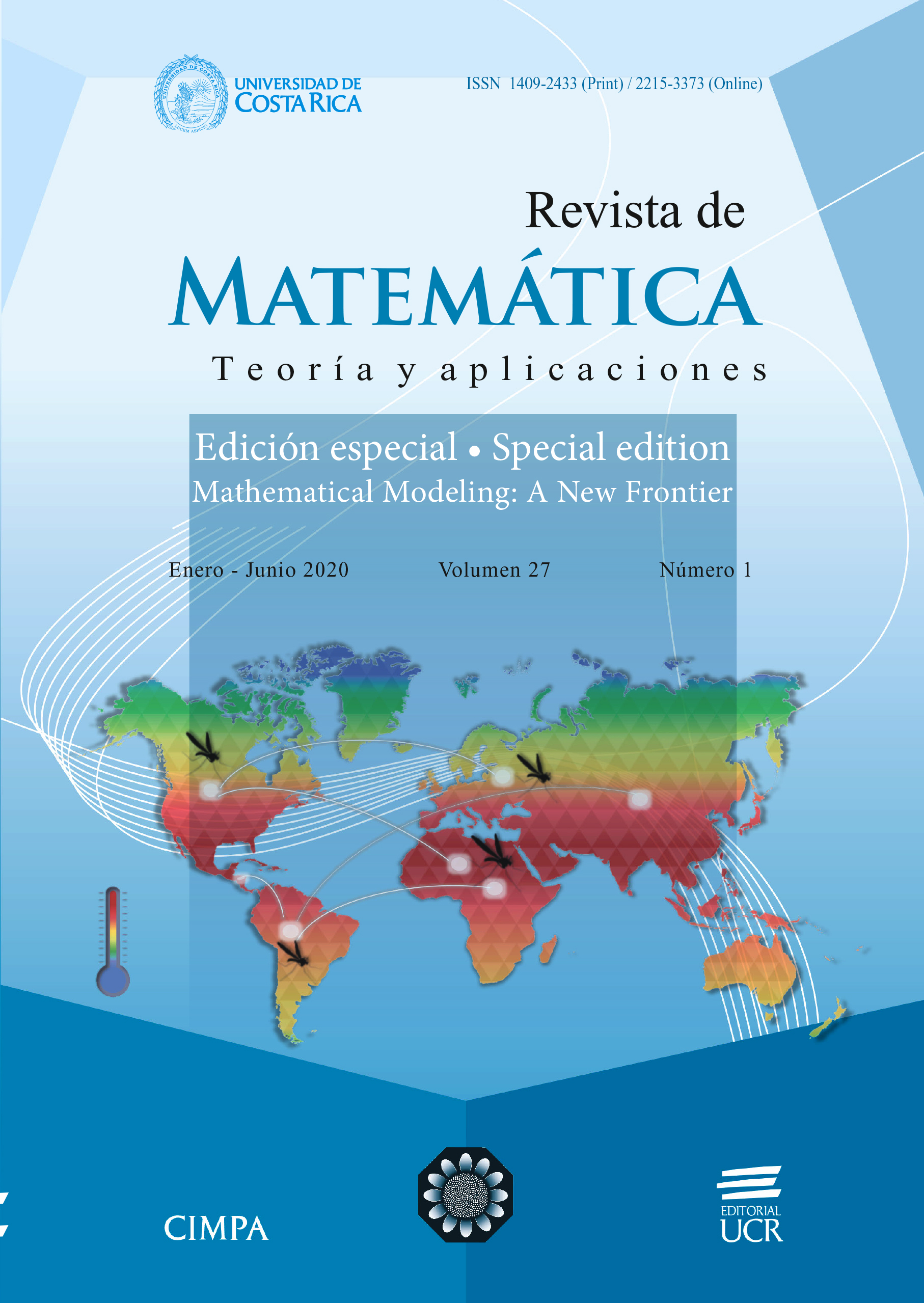Abstract
The propagation of infectious diseases and its impact on individuals play a major role in disease dynamics, and it is important to incorporate population heterogeneity into efforts to study diseases. As a simplistic but illustrative example, we examine interactions between urban and rural populations on the dynamics of disease spreading. Using a compartmental framework of susceptible–infected susceptible (SIS) dynamics with some level of immunity, we formulate a model that allows non linear reinfection. We investigate the effects of population movement in a simple scenario: a case with two patches, which allows us to model population movement between urban and rural areas. To study the dynamics of the system, we compute a basic reproduction number for each population (urban and rural). We also compute steady states, determine the local stability of the disease-free steady state, and identify conditions for the existence of endemic steady states. From our analysis and computational experiments, we illustrate that population movement plays an important role in disease dynamics. In some cases, it can be rather beneficial, as it can enlarge the region of stability of a disease-free steady state.
References
L. Alvarado, Costa Rica once again under malaria alert, The Costa Rica Star, 2018. Available at https://news.co.cr/ costa-rica-once-again-under-malaria-alert/73681, accessed 25/04/2019.
D. Bichara, C. Castillo-Chavez, Vector-borne diseases models with residence times — A Lagrangian perspective, Math. Biosci. 281(2016), 128–138. doi: 10.1016/j.mbs.2016.09.006
F. Brauer, C. Castillo-Chavez, Mathematical Models in Population Biology and Epidemiology, 2nd edition, Springer-Verlag, Providence RI, USA, 2012.
Center for Disease Control and Prevention, Severe acute respiratory system (SARS), 2019. Available at https://www.cdc.gov/sars/index. html
Center for Disease Control and Prevention, Ebola (Ebola virus disease), 2019. Available at https://www.cdc.gov/vhf/ebola/ history/2014-2016-outbreak/index.html
Center for Disease Control and Prevention, Measles (Rubeola), 2019. Available at https://www.cdc.gov/measles/index.html
G. Chowell, P.W. Fenimore, M.A. Castillo-Garsow C. Castillo-Chavez, SARS outbreaks in Ontario, Hong Kong and Singapore: The role of diagnosis and isolation as a control mechanism, J. Theor. Biol. 224(2003), no. 1, 1–8. doi: 10.1016/S0022-5193(03)00228-5
M.P. Coffee, G.P. Garnett, M. Mlilo, H.A.C.M. Voeten, S. Chandiwana, S. Gregson, Patterns of movement and risk of HIV Infection in rural Zimbabwe, J. Infect. Dis. 191(2005), no. 1, S159–S167. doi: 10.1086/ 425270
J.M. Crutcher, S.L. Hoffman, Malaria, in: S. Baron (Ed.) Medical Microbiology, 4th edition, University of Texas Medical Branch at Galveston, Galveston TX, 1996, ch. 83. Available in: https://www.ncbi.nlm. nih.gov/books/NBK8584/
R. DeVore, A. Ron, Approximation of functions, Proc. Sympos. Appl. Math.36(1986), 34–56.
Z. Feng, J. X. Velasco-Hernández, Competitive exclusion in a vector–host model for the dengue fever, J. Math. Biol. 35(1997), no. 5, 523–544. doi: 10.1007/s002850050064
Z. Feng, C. Castillo-Chavez, A. F. Capurro, A model for tuberculosis with exogenous reinfection, Theor. Popul. Biol. 57(2000), no. 3, 235–247. doi: 10.1006/tpbi.2000.1451
H. Frankowska, The Poincaré–Miranda theorem and viability condition, J. Math. Anal. Appl. 463(2018), no. 2, 832–837. doi: 10.1016/j.jmaa. 2018.03.047
J. Gjorgjieva, K. Smith, G. Chowell, F. Sanchez, J. Snyder, C. CastilloChavez, The role of vaccination in the control of SARS, Math. Biosci. Eng. 2(2005), no. 4, 753–769. doi: 10.1006/tpbi.2000.1451
J.R. Glynn, J. Murray, A. Bester, G. Nelson, S. Shearer, P. Sonnenberg, Effects of duration of HIV infection and secondary tuberculosis transmission on tuberculosis incidence in the South African gold mines, AIDS 22(2008), no. 14, 1859–1867. doi: 10.1097/QAD.0b013e3283097cfa.
J.L. Grun, W.P. Weidanz, Antibody-independent immunity to reinfection malaria in B-cell-deficientmice, Infect. and Immun. 41(1983),no.3,1197– 1204.
W. Kulpa, The Poincaré–Miranda theorem, Amer. Math. Month. 104(1997), no. 6, 545–550. doi: 10.2307/2975081
S.Lee,C.Castillo-Chavez,The role of residence times in two-patch dengue transmission dynamics and optimal strategies, J. Theor. Biol. 374(2015), no. 7, 152–164. doi: 10.1016/j.jtbi.2015.03.005
C.A. Manore, K.S. Hickmann, S. Xu, H.J. Wearing, J.M. Hyman, Comparing dengue and chikungunya emergence and endemic transmission in A. aegypti and A. albopictus, J. Theor. Biol. 356(2014), 174–191. doi: 10.1016/j.jtbi.2014.04.033
P. Martens, L. Hall, Malaria on the move: Human population movement and malaria transmission, Emerg. Infect. Diseas.6(2000), no. 2, 103–109. doi: 10.3201/eid0602.000202
D. Murillo, S. Holechek, A. Murillo, F. Sanchez, C. Castillo-Chavez, Vertical transmission in a two-strain model of dengue fever, Lett. Biomath. 1(2014),no.2,249–271.doi: 10.1080/23737867.2014.11414484
R. Pastor-Satorras, C. Castellano, P. van Mieghem, A. Vespignani, Epidemic processes in complex networks, Rev. Mod. Phys. 87(2015), no. 3, 925–979.
F. Sanchez, M. Engman, L.C. Harrington, C. Castillo-Chavez, Models for dengue transmission and control, in: A.B. Gumel, C. Castillo-Chavez, R.E. Mickens & D.P. Clemence (Eds.) Mathematical Studies on Human Disease Dynamics. Emerging Paradigms and Challenges, Contemp. Math. 410, Amer. Math. Soc., Providence RI, USA, 2006, pp. 311–326. doi: 10.1090/conm/410/07734
F. Sanchez, X. Wang, C. Castillo-Chavez, D. Gorman, P.J. Gruenewald, Drinking as an epidemic — A simple mathematical model with recovery and relapse, in: K.A. Witkiewitz & G.A. Marlatt (Eds.) Therapist’s Guide to Evidence-Based Relapse Prevention, Academic Press, Cambridge, MA, USA, 2007, pp. 353–368. doi: 10.1016/B978-012369429-4/ 50046-X
F. Sanchez, D. Murillo, C. Castillo-Chavez, Change in host behavior and its impact on the transmission dynamics of dengue, in: R.P. Mondaini (Ed.) International Symposium on Mathematical and Computational Biology, BIOMAT 2011 (Santiago, Chile), 2012, pp. 191–203. doi: https: //doi.org/10.1142/9789814397711_0013
F. Sanchez, J. G. Calvo, E. Segura, Z. Feng, A partial differential equation model with age-structure and nonlinear recidivism: Conditions for a backward bifurcation and a general numerical implementation, Computers and Mathematics with Applications 78(2018), no. 12, 3916–3930. doi: url10.1016/j.camwa.2019.06.021
B. Song, M. Castillo-Garsow, K.R. Rios-Soto, M. Mejran, L. Henso, C. Castillo-Chavez, Raves, clubs and ecstasy: The impact of peer pressure, Math.Biosci.Eng.3(2006),no.1,249–266.doi: 10.3934/mbe.2006. 3.249
B. Song, W. Du, J. Lou, Different types of backward bifurcations due to density-dependent treatments, Math. Biosci. Eng. 10(2013), no. 5–6, 1651–1668. doi: 10.3934/mbe.2013.10.1651
K. Szyma´nska-De¸bowska, On a generalization of the Miranda Theorem and its application to boundary value problems, J. Diff. Equ. 258(2015), no. 8, 2686–2700. doi: 10.1016/j.jde.2014.12.022
A.J. Treno, P.J. Gruenewald, L.G. Remer, F. Johnson, E.A. LaScala, Examining multi-level relationships between bars, hostility and aggression: Social selection and social influence, Addiction 103(2007), no. 1, 66–77. doi: 10.1111/j.1360-0443.2007.02039.x
M.Turzánski, The Bolzano–Poicaré–Mirandatheorem—Discreteversion, Topol. Appl. 159(2012), no. 13, 3130–3135. doi: 10.1016/j.topol. 2012.05.026

